« August 2014 |
Main
| October 2014 »
 September 25, 2014 | Vamps summary. How to amaze and impress your friends.
September 25, 2014 | Vamps summary. How to amaze and impress your friends.
One of the series we are most proud of was our 2012 comprehensive approach to Vamps in which we mapped out some common 3-note comping patterns you can apply to a myriad of tunes. These were even placed into permanent history as a Lesson Archive at the Mandolin Cafe
If you do nothing else on the site, at least make sure to dig into them. Amaze and impress your fellow musicians:
Vamps Pt 1. Creating energy with Diatonic triads
Vamps Pt 2. Expanding the Diatonic triads
Vamps Pt 3. Scurry Dominants
Vamps Pt 4. Circle of fifths
Vamps Pt. 5 Minor Modal
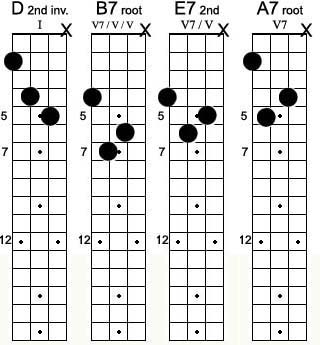
Along the same lines was our series on 7th Chord Streams, Major and Minor. If you haven't already, be sure to print out the two page PDFs of the chords there. They are especially good for the 5-string mandolinist or tenor guitar/mandolaist.
Posted by Ted at 4:16 PM
 September 18, 2014 | Passing Chords. Fill in the gaps.
September 18, 2014 | Passing Chords. Fill in the gaps.
You're probably familiar with passing notes or passing "tones." These are the notes that connect the important chord relevant tones in a melody. They aren't part of the chord, but they give a linear dimension, creating melody. You can do the same thing with chords, though.
We've written about this before, how you can take static measures of chords, say an AbMaj7 for two measures, and color them with passing chords. Instead of two measures, eight beats of Ab, you follow two beats of AbMaj7 with two of Bbm7, two Cm7, and two DbMaj7. It supports the tonal center of Ab, but injects progression, motion if you will.
You can move this pattern up the fretboard based on roots and create a whole new approach to your comping. Learn several more simple inversions and you can be a master of motion in your comping.
We covered this in a October 2006 Mandolin Sessions article. If you'd like to add a few more of these to your arsenal, check the article out: Chords in Passing; Exploring Diatonic Chord Progressions
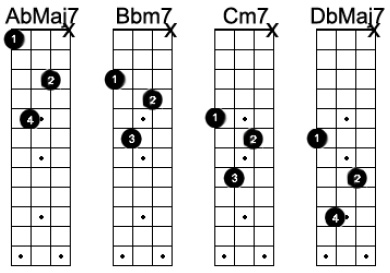
Further
Fitting in with triads
Creating energy with Diatonic triads.
Static Changes: V7 chords
More Three-note chords to supercharge your comping
Posted by Ted at 3:33 PM
 September 11, 2014 | Best of JM: Fretboard Geometry
September 11, 2014 | Best of JM: Fretboard Geometry
Enjoy the popular archive material below.
From October 14, 2010 | Fretboard Geometry
Intellect. Touch. Space. Sound. Everyone attacks the way they master their instrument differently, utilizing these individual components of playing. Initially, most of us just feel the position of the finger or fingers on the strings, and hopefully, we're rewarded by a pleasant sound. As we progress, we start to notice relationships. These can be as complex as music theory, the mathematical relationships between notes and their function through time, or it can be as simple as the just the way the notes or chords feel after repetition in the fingers. Even the spatial relationships can register as a part of motor function and how the music feels in the hands.
We talk a lot about the theory behind the mandolin here on the site. The dirty little secret of our 8-string wonder is you can move similar patterns with ease because of the magnificent symmetry of the 5ths tuning. It's as much a function of geometry as anything, and we want to take a look at some simple visual patterns and how they can be repeated up and down the fretboard, and across strings. You might absorb this tactilely eventually too, but we've blocked out some graphics to assist demonstrating the concept.
The instrument is traditionally tuned in 5ths. This means open string pairs will give you the drone Perfect Fifth, but it also gives you the same pairs relationship as you close up the strings and move it up the fretboard. That Power Chord A5, A and E is simply two strings next to each other. Move it up five frets and you have a Power D5. Shift it across a string and you have an E5.
So what? This is in essence your 'I, IV, V' chord, repeatable in numerous keys and transpositions. Whole musical careers have been launched on little more than these chords, and you can do it with just one finger on the mandolin. The Power 5 chord is not just a Rock and Roll sound, it offers some delicious ambiguity in contemporary music, the with the lack of definitive "major-ness" or "minor-ness." It was also a big hit with the Gregorian Monks back in Medieval times.
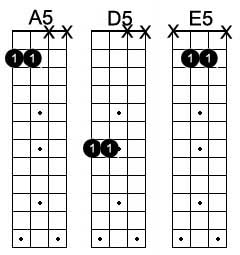
You can get a similar sound from its inversion, putting the 5th of the chord in the bottom, and the root at the top. This is also as important melodically as it is harmonically. Think of several tunes that start on the 5th of the scale, "Here Comes the Bride," "How High the Moon," "Ornithology," as examples. If you have identified the root of the scale or chord, the relationship on the fretboard is always the same, down a string, up two frets. That geometric relationship is a good trick to know. Now you have two notes you can immediately jump to when your improvising. It's just a matter of filling out the notes of the scale in between.
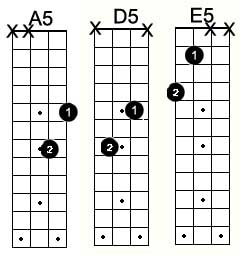
When we close in that two fret span to just one, we have an alluring aural treasure, the Tritone or the diminished 5th (#4). This is fretboard geometry you can exploit any time you play a Dominant 7th chord. It's the guts of the V7 chord, and powerful harmonic fodder. When you recognize and physically internalize this relationship, you can have all kinds of fun landing on it while improvising.
 
You can also slide it down some frets and develop a whole sequence of Circle of Fifths patterns. You don't need all four notes of the chord, these two are powerful enough on their own.
These are 5ths and 4ths, easily grasped on the mandolin fretboard, but you can also have some fun with 3rds. The following is a great little pattern you can move up and down in different keys and and harmony to your own melody. Notice graphically, sometimes there is a one fret span and sometimes there are two, depending on where you are in the scale. Getting to know where those are will give you some powerful tools for creating melody and harmony in almost any genre of music.
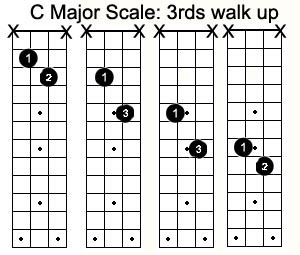
Many feared studying geometry in school, but ultimately found it useful in life, whether shopping for carpet or learning to parallel park. On the mandolin, geometry is your friend too. Use it as yet another tool for fretboard mastery.
Further:
Exploring Diatonic Chord Progressions
GRIP #1
Mobility--chord transit
Two-chord jam; feed the beast.
Posted by Ted at 1:30 PM
 September 4, 2014 | Best of JM: Turning scales and arpeggios into music
September 4, 2014 | Best of JM: Turning scales and arpeggios into music
Enjoy the popular archive material below.
From September 29, 2011 | Turning scales and arpeggios into music
Teachers of of beginning musicians will tell you practicing scales and arpeggios are crucial to learning how to play music. Teachers of advanced musicians will tell you practicing scales and arpeggios teach you how to sound like you're playing scales and arpeggios...
We're big on conquering these fundamental ingredients, scales, modes, and breaking chords into linear melody, but there's no question you can't stop there. This skill is merely a jumping off point, an ability that makes you more efficient in the aesthetic process of improvising and creating your own music. So how do you NOT sound like your playing scales in your solo? Here are a few tricks up your sleeve, and we suggest you implement this into your own practice routine. Don't just play a scale. Once you get it into your fingers, try altering it in some of these ways.

Reverse course. Bottom note G, High note G, and all the notes of the G Major scale in between. You ascend, then you descend. Sounds great, but how many times does this incarnation of the scale happen in real music? If you really want to master a major scale, try starting on the top note, descend, and then ascend again. Guarantee this is a new skill and somewhat uncomfortable if you haven't tried it before. Still, this is what happens in "real life," so practice this way once in a while.
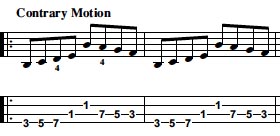
Start in the middle. Next step to this altering direction is to alter the starting point. Try starting from the 3rd scale degree and play up, down and back. Again, this is real life. Start on the 5th scale degree. Rarely does a passage of music starts on the first note of a scale, so once in awhile you should practice this way.
Break it up. In our FFcP studies we practice broken 3rds and 4ths, another good way of playing a scale--without sounding like a scale.

Syncopate the harmonic rhythm. When you start a scale on the tonic, at least the first half of the scale as you playing 1, 3, 5, on the strong beats, which outlines the chord on the strong beats. If you started on 2 instead, and went, 2, 1, 2, 3, 4, 5, etc., you'd have the 1, 3, 5 chord on the upbeats. The end result is harmonic rhythm "syncopation." It's a nice effect you should plug into your solos.
Add chromatic leading tones. Determine a staring note of the scale, but precede it with a half step (up or down) leading note. For example, lead into a Bb Major Scale with a single Ab. Ornamenting your scales in this way conditions you to solo with more creativity. Playing the blues in G, you could precede any D with a Db. Instant blues!
These are great spice "condiments" to add to the culinary routine of practice. See how musical you can make a vanila scale routine sound.
Further:
Approaching Improvisation
Improvisation: Pattern Based VS. Theory Based
Critical Decisions in Improvising: 'Gravity' Notes
Suspicion of Melodic Intent
Spelling out the chords melodically
Posted by Ted at 9:01 PM

Disclaimer: In the 'Information Age' of the 21st Century,
any fool with a computer, a modem, and an idea can
become a self-professed 'expert." This site does not
come equipped with 'discernment.'
|



